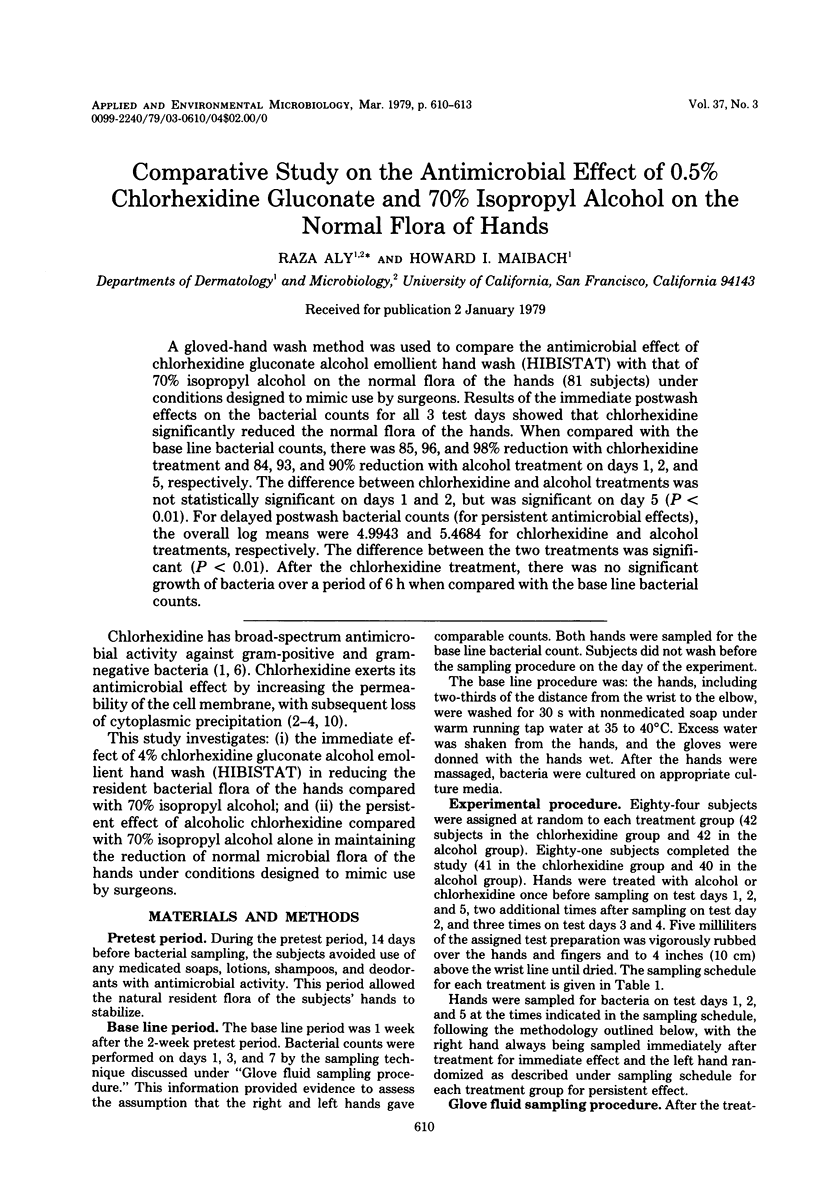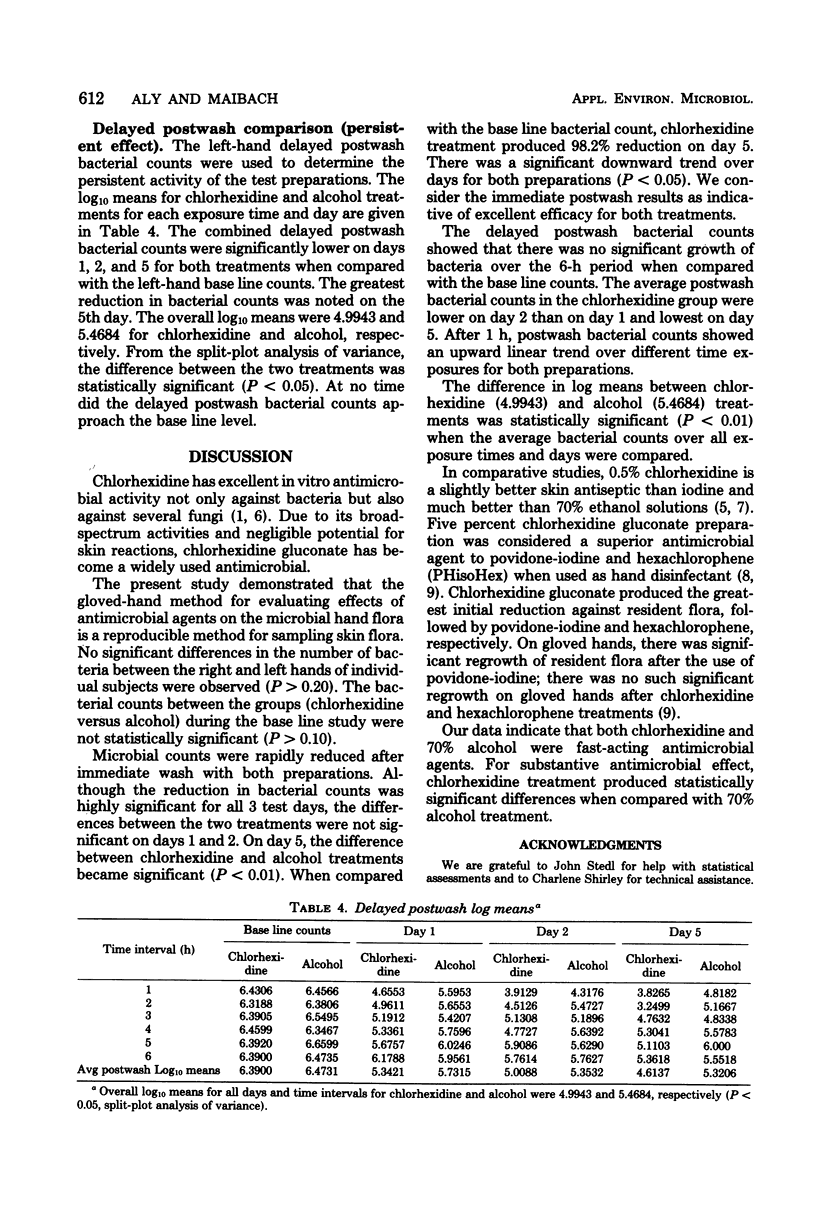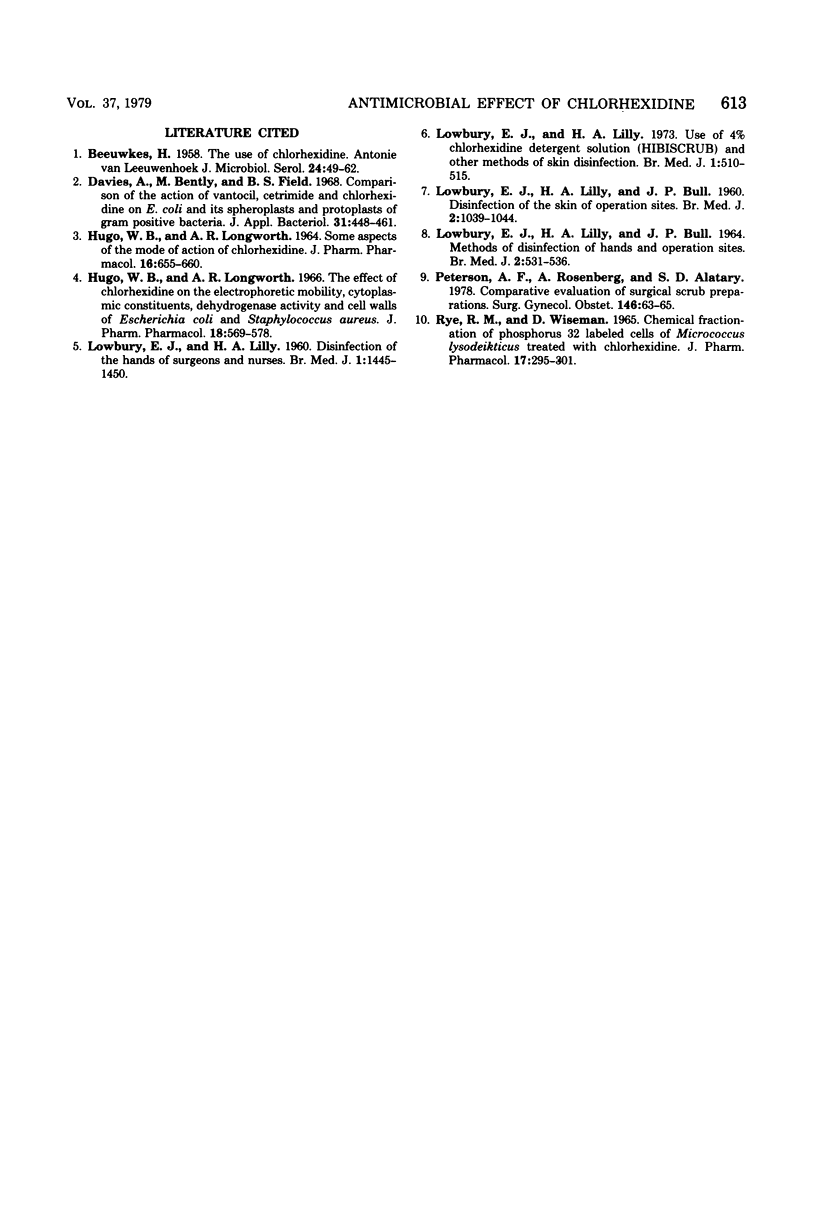Abstract
A gloved-hand wash method was used to compare the antimicrobial effect of chlorhexidine gluconate alcohol emollient hand wash (HIBISTAT) with that of 70% isopropyl alcohol on the normal flora of the hands (81 subjects) under conditions designed to mimic use by surgeons. Results of the immediate postwash effects on the bacterial counts for all 3 tests days showed that chlorhexidine significantly reduced the normal flora of the hands. When compared with the base line bacterial counts, there was 85, 96, and 98% reduction with chlorhexidine treatment and 84, 93, and 90% reduction with alcohol treatment on days 1,2, and 5, respectively. The difference between chlorhexidine and alcohol treatments was not statistically significant on days 1 and 2, but was significant on day 5 (P less than 0.01). For delayed postwash bacterial counts (for persistent antimicrobial effects), the overall log means were 4.9943 and 5.4684 for chlorhexidine and alcohol treatments, respectively. The difference between the two treatments was significant (P less than 0.01). After the chlorhexidien treatment, there was no significant growth of bacteria over a period of 6 h when compared with the base line bacterial counts.
Full text
PDF



Selected References
These references are in PubMed. This may not be the complete list of references from this article.
- BEEUWKES H. The use of chlorhexidine. Antonie Van Leeuwenhoek. 1958;24(1):49–62. doi: 10.1007/BF02548431. [DOI] [PubMed] [Google Scholar]
- Davies A., Bentley M., Field B. S. Comparison of the action of vantocil, cetrimide and chlorhexidine on Escherichia coli and its spheroplasts and the protoplasts of gram positive bacteria. J Appl Bacteriol. 1968 Dec;31(4):448–461. doi: 10.1111/j.1365-2672.1968.tb00394.x. [DOI] [PubMed] [Google Scholar]
- HUGO W. B., LONGWORTH A. R. SOME ASPECTS OF THE MODE OF ACTION OF CHLORHEXIDINE. J Pharm Pharmacol. 1964 Oct;16:655–662. doi: 10.1111/j.2042-7158.1964.tb07384.x. [DOI] [PubMed] [Google Scholar]
- Hugo W. B., Longworth A. R. The effect of chlorhexidine on the electrophoretic mobility, cytoplasmic constituents, dehydrogenase activity and cell walls of Escherichia coli and Staphylococcus aureus. J Pharm Pharmacol. 1966 Sep;18(9):569–578. doi: 10.1111/j.2042-7158.1966.tb07935.x. [DOI] [PubMed] [Google Scholar]
- LOWBURY E. J., LILLY H. A., BULL J. P. Disinfection of the skin of operation sites. Br Med J. 1960 Oct 8;2(5205):1039–1044. doi: 10.1136/bmj.2.5205.1039. [DOI] [PMC free article] [PubMed] [Google Scholar]
- LOWBURY E. J., LILLY H. A., BULL J. P. METHODS FOR DISINFECTION OF HANDS AND OPERATION SITES. Br Med J. 1964 Aug 29;2(5408):531–536. doi: 10.1136/bmj.2.5408.531. [DOI] [PMC free article] [PubMed] [Google Scholar]
- LOWBURY E. J., LILLY H. A. Disinfection of the hands of surgeons and nurses. Br Med J. 1960 May 14;1(5184):1445–1450. doi: 10.1136/bmj.1.5184.1445. [DOI] [PMC free article] [PubMed] [Google Scholar]
- Lowbury E. J., Lilly H. A. Use of 4 per cent chlorhexidine detergent solution (Hibiscrub) and other methods of skin disinfection. Br Med J. 1973 Mar 3;1(5852):510–515. doi: 10.1136/bmj.1.5852.510. [DOI] [PMC free article] [PubMed] [Google Scholar]
- Peterson A. F., Rosenberg A., Alatary S. D. Comparative evaluation of surgical scrub preparations. Surg Gynecol Obstet. 1978 Jan;146(1):63–65. [PubMed] [Google Scholar]
- Rye R. M., Wiseman D. Chemical fractionation of phosphorus-32 labelled cells of Micrococcus lysodeikticus treated with chlorhexidine. J Pharm Pharmacol. 1965 May;17(5):295–301. doi: 10.1111/j.2042-7158.1965.tb07670.x. [DOI] [PubMed] [Google Scholar]


